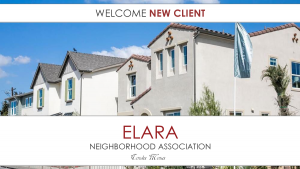*Asked & Answered
 Asked – Our association has two homeowners that have requested the association’s intervention to assist with resolving a dispute that has arose from damage to a shared wall. Should the Board get involved? Does the Association have any responsibility to cover the cost to repair the shared wall?
Asked – Our association has two homeowners that have requested the association’s intervention to assist with resolving a dispute that has arose from damage to a shared wall. Should the Board get involved? Does the Association have any responsibility to cover the cost to repair the shared wall?
Answered – As a general matter, the Association is not obligated to intervene in this neighbor-to-neighbor dispute and is not responsible for covering the cost of the damage to the shared wall (“Party Wall”).
California Civil Code § 4775 provides the general allocation of maintenance responsibilities between associations and individual homeowners as follows, “unless otherwise provided in the declaration of a common interest development, the association is responsible for repairing, replacing, and maintaining the common area.” (Civ. Code § 4775(a)(1). Emphasis added.) The code further provides that “[u]nless otherwise provided in the declaration of a common interest development, the owner of each separate interest is responsible for repairing, replacing, and maintaining that separate interest.” (Id. at (a)(2). Emphasis added.)
In this situation, the damaged Party Wall is located between two private lots, not on the Association common area. As such, absent any provision in the association’s governing documents to the contrary, the association has no obligation to repair the Party Wall.
This point is further clarified by California Civil Code § 841(a), which states, in pertinent part: “[a]djoining landowners shall share equally in the responsibility for maintaining the boundaries and monuments between them.” Which, necessarily, would include the damaged Party Wall. This maintenance obligation extends to “reasonable costs of construction…or necessary replacement of the fence.” (Civ. Code § 841(b)(1).)
There may be circumstances where the Board of Directors (“Board”) may sympathize with the homeowners and want to intervene (eg. the damage to the Party Wall was no fault of the homeowners). While this feeling is valid and shows the Board’s virtues, the Board should remember that they are fiduciaries of the Association and must act in the best interests of the association as a whole.
The Board lacks the authority to expend association funds to repair the damaged Party Wall. The association levy’s and collects assessments from its owners for various reasons including among other things, promoting its members’ welfare, improving and maintaining association property, and discharging association obligations under their governing documents. However, covering the cost of the Party Wall, which is a separate interest, would be outside the scope of the association’s authority.
Thus, the association has no obligation or authority to intervene with this dispute and make the repairs to the damaged Party Wall. That burden lies solely with the homeowners.
 |
In addition to the above, prudent associations adopt neighbor-to-neighbor dispute policies to offset many disputes that can likely be resolved with effort between the homeowners. |
-Blog post authored by TLG Attorney, Corey L. Todd, Esq.
 It’s our privilege to welcome Manana Homeowners Association to Tinnelly Law Group’s growing family of HOA clients.
It’s our privilege to welcome Manana Homeowners Association to Tinnelly Law Group’s growing family of HOA clients. HOA Lawyer Blog
HOA Lawyer Blog


 *New Case Law
*New Case Law It’s our privilege to welcome Gatehouse Condominium Homeowners Association to Tinnelly Law Group’s growing family of HOA clients.
It’s our privilege to welcome Gatehouse Condominium Homeowners Association to Tinnelly Law Group’s growing family of HOA clients. It’s our privilege to welcome Gaslamp City Square Property Owners’ Association to Tinnelly Law Group’s growing family of HOA clients.
It’s our privilege to welcome Gaslamp City Square Property Owners’ Association to Tinnelly Law Group’s growing family of HOA clients. Asked – Several members of our association have requested that we convert a portion of our common area into a pickleball court. Does your office recommend moving forward with the installation?
Asked – Several members of our association have requested that we convert a portion of our common area into a pickleball court. Does your office recommend moving forward with the installation? It’s our privilege to welcome Auburn Heights Homeowners Association to Tinnelly Law Group’s growing family of HOA clients.
It’s our privilege to welcome Auburn Heights Homeowners Association to Tinnelly Law Group’s growing family of HOA clients. It’s our privilege to welcome Elara Neighborhood Association to Tinnelly Law Group’s growing family of HOA clients.
It’s our privilege to welcome Elara Neighborhood Association to Tinnelly Law Group’s growing family of HOA clients. Asked – Our association has two homeowners that have requested the association’s intervention to assist with resolving a dispute that has arose from damage to a shared wall. Should the Board get involved? Does the Association have any responsibility to cover the cost to repair the shared wall?
Asked – Our association has two homeowners that have requested the association’s intervention to assist with resolving a dispute that has arose from damage to a shared wall. Should the Board get involved? Does the Association have any responsibility to cover the cost to repair the shared wall? It’s our privilege to welcome The Emerald Glen Homeowners’ Association to Tinnelly Law Group’s growing family of HOA clients.
It’s our privilege to welcome The Emerald Glen Homeowners’ Association to Tinnelly Law Group’s growing family of HOA clients. It’s our privilege to welcome Manitou Springs Homeowners Association to Tinnelly Law Group’s growing family of HOA clients.
It’s our privilege to welcome Manitou Springs Homeowners Association to Tinnelly Law Group’s growing family of HOA clients.